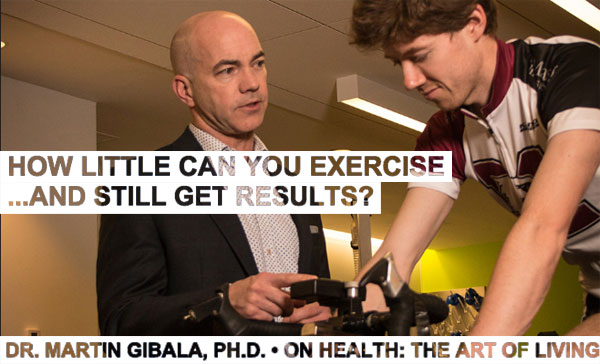Episode 4 | Dr. Martin Gibala | Does 1-Min of High Intensity Exercise Equal 45-Mins of Moderate Exertion?

PLAY & LISTEN…YOU WON’T BELIEVE THIS RESEARCH!
NO TIME TO LISTEN? READ IT HERE…
This article was based on a new study on interval training conducted by today’s guest, Martin Gibala. Dr. Gibala is a professor and chair of the Department of Kinesiology at McMaster University in Ontario. He conducts applied research that examines the impact of exercise and nutrition on your heath and performance. He is also the author of over 100 peer-reviewed scientific articles, most of which are focused on the physiological adaptations from interval training.
Can you give us a quick overview of the study?
We were interested in comparing a high-intensity workout to a traditional, moderate-intensity approach. We had three test groups: One test group did three 50-minute sessions per week at a moderate pace; one group did three 10-minute sessions which included a warm-up, cool down, some recovery periods of light exercise, and three 20-second all-out bursts of cycling (one full minute of vigorous exercise set within a 10-minute time commitment); a third control group did nothing.
What prompted you to study the very short duration of interval training?
We’ve been doing interval training research for a number of years, and some of the other protocols for bursts of exercise (with 4-5 minutes of recovery time in between), were about 25-30 minutes in duration from start to finish. With these workouts you are already on the lower end of the public health guideline which calls for 75 minutes per week of vigorous exercise. We wanted to answer the question of how little you could get away with, to devise a program to compare time-efficient, short, vigorous workouts with the more traditional approach.
What kinds of results were you testing for?
We were interested in three things:
1. Cardiorespiratory fitness (the ability of the body to deliver oxygen through the body), which is an independent risk factor for dying and developing many different chronic conditions.
2. Insulin sensitivity (a measure of how the body controls blood sugar). We used an intravenous glucose tolerance test to monitor how blood sugar was handled over time.
3. We directly sampled pieces of the subjects’ muscle. As a muscle physiologist, I’m interested in the remodeling of the skeletal muscle. We use a needle biopsy to examine small components of muscle and see how the structure of the muscle changes in response to the workouts.
If people fall into a pattern of exercising long and slow (60-70% intensity), are they missing something in terms of their fitness and health?
It depends: in humans, there aren’t many changes in muscle fiber type, so it’s difficult to convert one fiber type to the other, but you can cause positive adaptations in these muscle fibers when you engage them. One school of thought is that interval training/high intensity exercise helps you recruit your large, powerful motor units that innervate fast-twitch muscle fibers, so part of the response is that these fibers are engaged and then adapt to the training. It is possible to engage or recruit all muscle fibers if you exercise long enough, but that results in fatiguing exercise.
Do you burn more calories after a HIIT session?
The after-burn effect is fact, but is often overstated. We’ve measured it in the laboratory and found that you have a higher metabolic rate for a period of time in recovery (which adds up over time). In our lab, we’ve seen that high intensity workouts can burn just as many calories over 24 hours as a longer, more traditional workout.
Fact or fiction: is HIIT appropriate for anybody?
Many people may think interval training is strictly an all-out, extreme pace. However, it simply refers to the basic concept of alternating periods of high-intensity with periods of rest for recovery. For some people, interval training may mean walking faster, then backing off. Studies have shown that people with diabetes may receive more benefit from interval walking versus walking at a consistent pace. It’s more likely there are specific interval training approaches that are best for certain groups of people. I’ve created various walking audios through the years, and I tie the pace of the walk to the pace of the music. When a song has a livelier beat, you’ll notice you are walking faster, and pretty soon your steady state is faster.
We used to recommend you only do interval training a couple times a week. Is this still the case? Do you need a longer recovery after a HIIT workout?
It depends on your goals. If you’re a high performance athlete, the amount of times you do interval training for performance is different than the number of times someone who is engaging in HIIT for health benefits would require. It also depends on the intensity of the intervals – it’s an uncomfortable form of exercise! – as well as the type of exercise you are doing (for example, interval running will be tougher on the joints than interval cycling or swimming). Most of our studies have been on interval training done three times per week. For some people, once per week is sufficient. It depends on your goals, and what you want in terms of time efficiency and overall health.
Is there a certain type of fat that is targeted by HIIT?
Some evidence indicates that visceral stores of adipose tissue may be reduced to a greater extent with interval training. The jury is still out, though.
You’ve been studying interval training for over a decade now. What prompted you to get involved in this type of research?
I became involved for both personal and professional reasons. Professionally, I teach a specialized course called The Integrative Physiology of Human Performance. The students in this class are interested in the training programs of elite athletes, and they are always curious about how these decorated athletes would utilize interval training when it is classified as “anaerobic” exercise. Further, what about middle-distance Olympians who trained exclusively using intervals? On a personal level, I lead a busy life and have found intervals to be a good way to maintain fitness when I don’t have a lot of free time. Over time, we’ve found more interesting questions to ask with this research, and we can use it to study performance, basic molecular adaptation, and health-related adaptations. I enjoy HIIT because it’s much less boring; the intervals keep me more engaged. I also have a daughter who is a track athlete – right now she’s ranked #1 in the United States and she’ll be heading to the Olympic trials soon – and so much of her work is interval training.
If you want to save your joints and energy, how do you make your workouts more efficient?
Clearly there’s always a risk of over-training, but you can make a case that over-training is more related to the volume of training as opposed to the intensity. Interval training can be very effective and is a potent way to improve aerobic conditioning. Even though most energy in a single sprint comes from non-aerobic sources, when you do repeated sprints most energy comes from the aerobic system. It’s not a surprise that we see improvement in the aerobic energy system, which equally benefits health and performance.
Are there modifications to HIIT you would make for the aging layperson?
Of course my perspective is as a professor; I am not a medical doctor and any time you make a change to your exercise routine you should consult with your physician. What I’ve found is to use common sense. If you’re new to HIIT, start by simply getting out of your comfort zone. Do not go from 0 – 60 overnight! In terms of older individuals, we have done training research with people in their mid-late 60’s and in general these individuals don’t want to do all-out sprint type intervals, but rather should back off on the maximum intensity they use. This is consistent with the advice that prominent cardiologists in the field would recommend. Having said that, it’s a very individual approach based on your health and what your physician recommends.
Have you done much research on nutrition and diet in relation to HIIT?
We’ve done some studies where we try to manipulate nutrition by doing interval training in the morning after an overnight fast versus eating breakfast, or by doing two HIIT sessions in a day while we manipulate what the subject consumes in between sessions. We generally see subtle effects of nutrition, which may be because interval training is such a powerful stimulus for adaptation. In the end, do what’s best for you. If you hate to exercise on an empty stomach, don’t do it! There is generally no one-size-fits-all approach. If you’re an elite athlete, there are some subtle effects of nutrition before and after exercise that can influence overall responses. As soon as my daughter is done with her workout, she immediately needs to get a certain number of carbohydrates and protein into her system. Many studies I’ve been reading recently discuss the importance of nutrition in the period after working out. But it’s important for listeners to do what they feel comfortable doing. I like to have a little something in my stomach before working out. A lot of what feels good for us may even be psychological, but it’s good to know it’s not a make-or-break issue. Absolutely! Someone like your daughter who is a high performance athlete and is weight-stable wants to maximize performance and would carefully monitor intake throughout the day. On the other hand, it doesn’t make sense for someone who is interested in weight loss to be consuming a huge meal of protein or carbohydrate after exercise. It comes back to individualizing exercise and food for your goals and needs.
I read a quote recently which said “The difference between ‘try’ and ‘triumph’ is a little ‘umph.’” I think today’s takeaway is that we need a little more ‘umph’ in our workouts. If you haven’t tried interval training and it’s appropriate for you, I’ve found – and research has shown – that it can be a great addition to your regular workout routine.
STEP 1 – Walk off the pounds STEP 2 – Firm it up! STEP 3 – Stay consistent with 10-min workouts!









